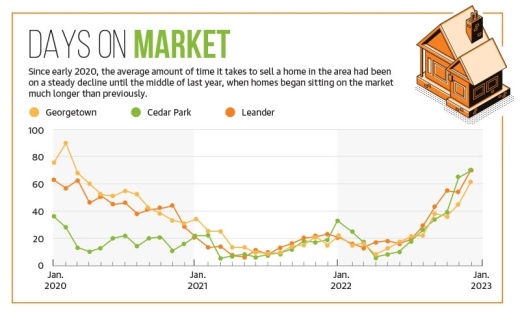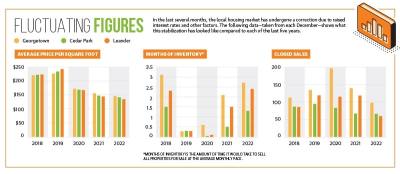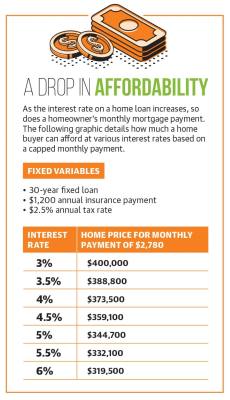However, industry experts anticipate offers on homes to start increasing, and many see the sluggish pace experienced in late 2022 as a sign of a better-balanced market. It has allowed housing inventory to build up, although a wave of buyers moving to the area could deplete the supply.
Navigating the up-and-down nature of the real estate world could prove challenging at any time of the year, and as Georgetown continues to grow in population, competition with fellow movers will expand and contract in the coming months, local Realtors said. In the interim, these experts believe some homebuyers can take advantage of the current climate despite higher interest rates.
“If somebody really knows they need to move, they need to think about strategy,” said Tom Catlin, an agent at Keller Williams Realty in Georgetown.
Market slows
Fluctuation in market activity is natural, according to experts. The slowest time of the year for Realtors is Thanksgiving through December, and business typically picks back up in the spring and summer.
Still, the average time listings spent on the market in December—61 days—was the highest since the winter of 2019-20, when homes were on the market 67 days that December and 90 days in February 2020, according to data from the Austin Board of Realtors.
In contrast, listings in Georgetown during December 2021 spent 15 days waiting for a buyer on average.
Meanwhile, ABoR data shows home sales in the city decreased, going from 197 in December 2020 to 140 in December 2021 to 98 in December 2022.
Those in the industry attribute this drop in activity to multiple factors, including rising interest rates.
“People seeing interest rates in the 6[%]s—it’s really put the brakes on,” said Michael Howard, branch manager at Main Street Mortgage in Georgetown.
The average rate on a 30-year fixed home loan in December 2021 was 3.11%, according to data from Freddie Mac, the Federal Home Loan Mortgage Corp. By the end of 2022, it had reached 6.33% with the high point in November at 7.08%.
Rising interest rates can have a considerable effect on a person’s purchasing power, causing some hesitancy among potential buyers, Howard said.
“Those move-up buyers—those people who are looking because they’ve expanded their family, or they’re looking to get a bigger house—they generally refinanced during the refinance boom, or they bought when rates were in the 3[%]s or maybe even 2[%]s,” he said. “So they are really reluctant to let go of that interest rate to come into the 6[%]s.”
Building up inventory
The rise in interest rates, which has led to a decline in sales, has spurred home inventory in Georgetown.
The local market, according to ABoR, had 3.1 months of inventory in December, meaning if no more homes went up for sale, the market would dry up in around three months. In December 2021, inventory in the city was 0.3 months. A combination of low mortgage rates and a lack of inventory going into 2022 then created a “buying frenzy,” Howard said.
“There were five homes and 400 people out there shopping for them,” he said. “Now we’ve got the opposite, where there are five buyers out there looking and 500 homes to choose from.”
While the demand is not as high as it was a year ago, some agents are starting to see more buyers.
Sandra Davi and her husband moved to Georgetown in early January. After visiting several houses, the couple was able to use the profits from selling their New Jersey home to quickly find a new one.
“We found a home we fell in love with,” she said. “It only took us a few days to be quite honest.”
As inventory has gone up, home prices have come down. Costs dropped from an average price of $225 per square foot in December 2021 to $219 in December 2022, per ABoR data. The median price of homes sold decreased from $422,000 to $399,000 in that timespan.
“There’s a lot more inventory that’s building, and that’s actually a good thing for a buyer,” Howard said.
Future housing expectations
With interest rates starting to dip in late 2022, sales are expected to pick up in the new year, according to Realtors. Mortgage applications for the week of Jan. 13 increased 28% from the week prior, according to data from the Mortgage Bankers Association.
Housing experts now predict rates will go lower, which will provide buyers with some relief. Catlin said industry prognosticators believe rates could be 4.75%-5.25% by the end of 2023. He also said buyers have a couple of options to get the best deal for a new home, such as buying with a plan to refinance their mortgage when rates fall.
“If you wait too long, the circumstances may be somewhat punitive,” said Russ Phillips, a Georgetown real estate agent at Russ Phillips Team. “When interest rates come down, you can always refinance, but if you waited six months and interest rates came down, but prices went up, and it totally offset that, then you haven’t done yourself any favors.”
Interest rates often mirror inflation as the Federal Reserve tries to curb price growth. However, economists and investors will also be looking closely at 10-year U.S. Treasury notes as they are used as a benchmark that guide other consumer rates.
Another mechanism becoming popular among lenders, a two-one buy-down loan, allows for reduced mortgage payments for the first two years of a loan. Catlin said this is a tool homeowners who are having a hard time selling their house might entertain.
“They accept an offer, and part of the offer is that the sellers will contribute to buying down the [interest] rate for a period of two years,” he said. “That’s going to allow you to take advantage of a lower rate that doesn’t exist now and then refinance on a permanent basis within two years of closing.”
Slowing, not stopped
While bidding wars have stalled and sales have eased up, continued growth is still expected.
As major companies such as Samsung move into the area and ancillary businesses to support the tech giants pop up, the available jobs will continue to attract people to the region.
“Employers from around the country are looking at coming to Central Texas, and they’re finding a great talent pool up in Georgetown and in Williamson County,” said David Porter, executive director of the Williamson County Economic Development Partnership.
With roughly 75,000 Georgetown residents in 2020-21, according to U.S. census data, projections from Georgetown’s Planning Department have the city’s population rising to 89,000-110,000.
Catlin said the growing population and influx of new employment opportunities will continue to spur the housing market. So despite some homeowners sitting on the fence and waiting for the right moment to buy or sell, others will need to find a place to live sooner rather than later.
“A lot of people say all the sales happen during the summer because that’s when kids can move, but maybe a third of the homebuyers are families with children that that would affect,” Catlin said. “So we tend to pick up in March, and then it goes kind of crazy, relatively speaking, for the year.”
Home sales will likely peak around the Fourth of July, he said. Before then, interest rates, inflation, supply chain disruptions, construction costs and more will continue to influence the housing landscape. Maneuvering through these economic factors, meanwhile, will remain difficult for buyers and sellers.
“If you’re looking to time the market, you’re going to have to be lucky because it’s not a skilled thing,” Catlin said.







